| |
NCO Club, Bachelor Officer's
Quarters and the Enlisted Club: Three Buildings, Three Stories
Three buildings that remain from the American period at Daley
Barracks are the former NCO Club, former Bachelor Officer's
Quarters and the Enlisted Man's Club. The first two structures
have interesting stories that span the years from the early days
of Manteuffel Kaserne to the present. The EM Club dates back to
1952 and also survives.
The Frontier NCO Club
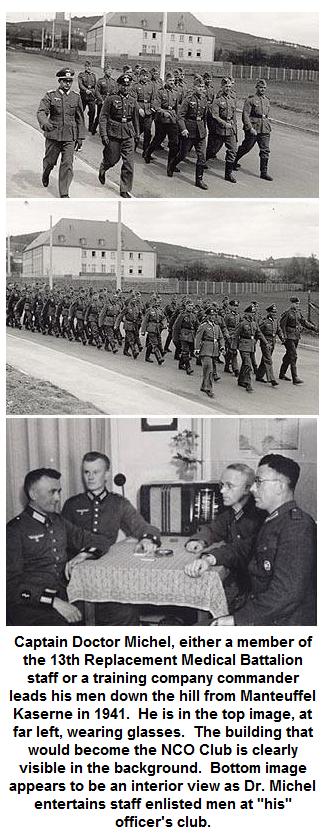
The impressive stone and stucco structure that we remember as the
Daley Barracks NCO Club dates from the early construction phase of
Manteuffel Kaserne in 1936. The records indicate that the land
acquisition and authorization for the building came after the
initial plan to develop the Kaserne. It is not known why this
delay occurred.
The building, named the "Offizier Heim und Kasino" followed one of
the standard blueprints used during this period. The function of
the building was to serve as the unmarried / unaccompanied
officers quarters, dining area and social club for those assigned
to Manteuffel Kaserne. Senior officers with families would likely
live in the city, however, all others would probably choose the
Offizier Heim. Because the motorcycle infantry battalions assigned
to Manteuffel spent comparatively little time at the barracks, the
building probably wasn't in full use until the Kaserne went to the
war years phase as a training center for the 13th Medical
Replacement Battalion.
From this period, we find excellent fotos of the exterior of
the Offizier Heim in the album created by the men of the 2nd
Training Company, 13th Medical Training Battalion to honor their
Commander, Doctor - Major Michel, on his 34 birthday in 1941. The
building appears in the background of several photographs.
Use of the building in the immediate post war period is
unclear. Manteuffel Kaserne was occupied by a variety of Army and
Army Air Force units, the clubs for the troopers were established
downtown. None of the people interviewed from that period have a
clear memory of the Offizier Heim building and its function. The
mystery continues through the three year period when no American
forces were at Manteuffel, 1947 - 1950. Perhaps the building was
simply shuttered.
The story of the building resumes with the remodeling program
at the future designated Daley Barracks as the 2/14 ACR occupies
their new home. The former Offizier Heim was renamed as the
Frontier NCO Club and configured for a new role. It is unknown to
what extent the interior was changed, clearly it lost the billet
and formal mess function but the changes were probably not
extensive. In this new capacity, it served the NCOs of Daley until
the barracks closed. Captioning evidence from the German
newspapers indicate that once Daley went to caretaker status, the
former club may have been used as a Community Recreation Center
for the US family members living at Daley Village.
With the final return of the barracks area
to German civil control, the former NCO club was spared
demolition but completely remodeled as the Bad Kissingen Civil
Police Station. The exterior, however, remains very similar to
that as remembered by troopers. Anyone with photos of the NCO
Club, either interior or exterior, please consider sending us
scans or copies.
Daley Barracks BOQ and Officers Club /
Marine Kurlazarett
The Daley Barracks Bachelor Officer's Quarters has an interesting
background and the story continues to this day. The history of
the building begins sometime just prior to WW I. It was built as
a Kur Hotel under
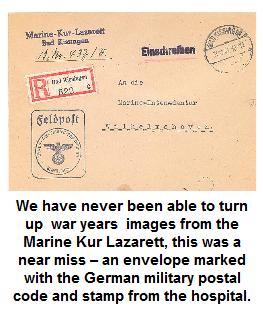 the control of the Imperial German Navy on one
of the last open parcels just off prestigious Kur Haus Strasse.
At about this same time, a long planned similar facility was
built on the south side of town for the Army. Respectively, the
two buildings were known as the Marinekurlazarett and the
Militar - Kuranstalt. The architectural scheme of the buildings
was similar, featuring open balconies, a partial Mansard roof
and ornate front. They easily fit in with the other less formal
Kur Hotels of the district. The back of the Marine- kurlazarett
building, perhaps as an economy measure, had a decidedly austere
look. The navy building served as a Kur vacation spot for
officers in the immediate pre war years. The army building was
probably a specialty clinic for more serious illnesses. Both
buildings quickly moved into the German military hospital system
once World War 1 began. the control of the Imperial German Navy on one
of the last open parcels just off prestigious Kur Haus Strasse.
At about this same time, a long planned similar facility was
built on the south side of town for the Army. Respectively, the
two buildings were known as the Marinekurlazarett and the
Militar - Kuranstalt. The architectural scheme of the buildings
was similar, featuring open balconies, a partial Mansard roof
and ornate front. They easily fit in with the other less formal
Kur Hotels of the district. The back of the Marine- kurlazarett
building, perhaps as an economy measure, had a decidedly austere
look. The navy building served as a Kur vacation spot for
officers in the immediate pre war years. The army building was
probably a specialty clinic for more serious illnesses. Both
buildings quickly moved into the German military hospital system
once World War 1 began.
Between the wars, the Marinekur building
remained under navy control. The army building seems to have
assumed a public clinic role, it also looked after older
veterans from a nearby building designated as a military nursing
home. In 1935, it was officially redesignated as the
Heereskurlazarett and was included in a 1939 survey of all
public accommodations in the city of Bad Kissingen; oddly the
Marinekurlazarett is not mentioned in this document.
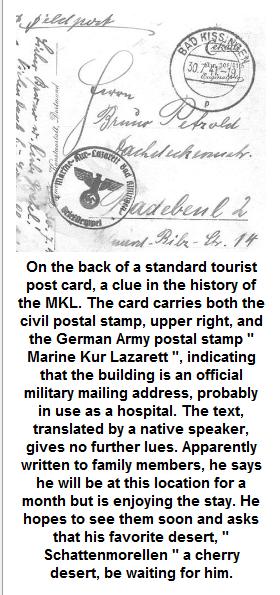
During the first year of the Second World War, the
Marinekurlazarett continued as a navy vacation resort and then,
like many other Kur hotels in Bad Kissingen, again became part of
the military hospital and recuperation system. An early war era
post card shows the unique German military postal stamp for this
building, evidence that it was in official Wehrmacht use. A few
blocks away, the Heerskur building was also part of the army
reserve hospital system but further references do not appear in
available documents.
The US
Army requisitioned most of the Kur district of the town for its
own use and as expected, the HQ of the 9th US Air Force occupied
much of the space and this includes the Marinekurlazarett
building. The German medical personnel moved out and the 2nd
Air Force Clearing Station, part of the 39th Field Hospital
moved in providing medical support to the local US forces at
least through the early Winter of 1945. As things stabilized
and troop levels drew down in 1946, the central part of Bad
Kissingen was returned to German control. Because the
Marinekurlazarett property was listed as belonging to the German
Navy through the Third Reich government, like Manteuffel Kaserne,
it was subject to immediate American requisition with no promise
of speedy return. For real property accountability, it was
considered part of the former German barracks. It is unknown
who, if anyone occupied the building once the 9th USAF medical
personnel departed. The next time the Army and the building can
be linked with any certainty is with the movement of the 2nd
Battalion, 14th Armored Reconnaissance to Bad Kissingen and the
revitalization of Manteuffel Kaserne renamed as Daley Barracks.
At that point, the building was reconfigured as the BOQ.
Why the Heereskurlazarett building was not requisitioned is
also unknown, perhaps it was simply considered excess to Army
needs. It was returned to the city of Bad Kissingen and began a
new life as a private clinic. The building still stands, much
modernized, on Bismarkstrasse, a specialty woman’s health
facility.
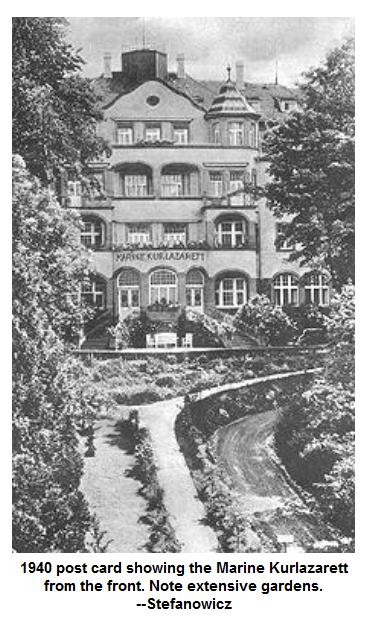
A late 1930s post card image of the Heerskurlazarett located on
Bismarkstrasse in Bad Kissingen. The US Army passed on retaining
this building after World War II. It is still in operation, much
remodeled and in civilian hands.
My first hand experience with the BOQ begins in 1978; the building
served the Daley Military Community with on site management and
accommodated three groups of service members. The basement level
quarters were occupied by senior grade unaccompanied NCOs, the
ground, second and third floor had quarters for unmarried /
unaccompanied officers and the top floor was configured as a
consolidated barracks space of the small female troop population
assigned to Daley: PAC, DENTAC and MEDAC. One set of ground floor
quarters was retained for VIP guests. From what I saw, there was
very little interaction between these three groups. There was a
communal TV and small lounge area by the entrance to the building
and a grand staircase running to the upper levels. Remodeled
during the upgrade program at Daley in 1972 - 73, the facilities
were first rate, even if the Cav Lts were seldom home. There was a
tenants parking lot adjacent to the building taking up a part of
the space once devoted to the formal gardens. The BOQ campus area
even had “ mystery “ bunker entrances and odd cone shaped air
vents in the lawn, all carefully secured.
The wing running from one side of the building held several
spaces, one of which served as the "on again - off again"
Officer's Club. A separate building just adjacent to the BOQ, once
served as an Officer's Mess. Bob Stauffer, assistant S1 with the
2/14 ACR, gets the story underway: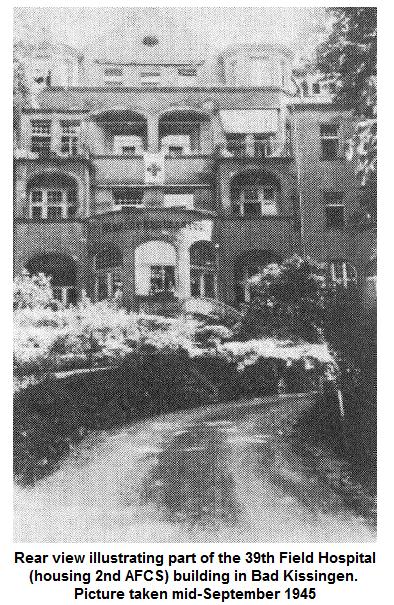
"In the early 1950s, I was a new Lt in Recon Company "F", then
became the Assistant S1 with the additional duty ' Club Officer '.
I was not with the unit when it moved from Schweinfurt to Bad
Kissingen but I can tell you the Officer's Mess and bar were in
operation in the Marine Hotel from the first days of the 14th Cav
in BK. I had a Mess NCO in charge of the place and a German staff
of waiters, cooks and a bartender. I recall we served breakfast
and supper every day, the most popular meal was 'brunch' on
Saturday and Sunday. "
"You may not know that the Germans had a formal bartender training
program, apprentice to journeyman and finally master grade. To
qualify to the highest level, it was necessary for the bartender
to invent a new drink. The O Club bartender, 'Fritzy', had
invented a cocktail called a 'Rakoczy', named after the local
mineral springs in the town. They were quite good; here are the
ingredients, I'll leave it up to you to experiment with the proper
proportions ... and have fun!"
Rakoczy:
quatro + lemon juice + vodka + champagne .... mix in crushed ice,
strain into a glass
Bob Kraimer, an Ordnance lieutenant assigned to the 2nd battalion,
14th ACR as the Battalion Motor Officer:
"I arrived in January 1955 and received quarters in the BOQ. At
the time, all the support activities for Daley Barracks were up
and running, the library, elementary school, Recreation Services.
There were a lot of American women employed in these activities
and they lived in the BOQ, on the second and third floors. The
officers had all moved to the top floor. At the end of a long day,
to hear an unmarried young woman speaking English in the same
building as our mess and Officer's Club ... well, it really was
pretty good even allowing for the three day alerts and long field
duty."
"By the way, Bob Stauffer was the only Lt I ever met who owned a
Porsche in Germany. He owned it but really, all of us helped him
pay for it .... Bob was the best poker player I ever met! There
was no English language TV and I really don't recall any radio
either ... just plenty of time to play cards. We took our uniforms
to the laundry point and then Bob took us to the cleaners!"
LTC (Ret) Willard C. Copp, with the 2/14 ACR from 1959 - 1962
recalls girl trouble at the BOQ: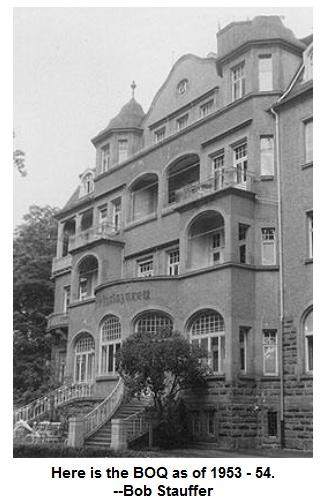
"I was commissioned as a Quartermaster but the way the Army ran
back then, one would spend eighteen months to two years in the
combat arms as a platoon leader and XO or secondary staff officer
prior to actual duty in the logistics / supply side of the house.
All this combat arms service was OJT, no basic course, just pick
it up on the way. So I found myself in the Tank Company first,
then one of the recon companies and on to the S3 staff before I
finally moved over to Daley Barracks Community in a logistics
function. The administration of the BOQ was one duty, both the
billet operations and the club. I recall that the German employees
had the day to day stuff under control and we had a manager of the
BOQ who handled that job with one exception."
"There was a rule that a German girl could not be left alone in US
Army quarters ... period. This applied to both family housing and
the BOQ. I would get a call, usually on a Monday morning from the
manager that the cleaning staff or someone else had identified a
German girl in room such and such of the BOQ. So, I would pick up
an MP or two, drive over, get the manager and his pass key and in
we would go like ' gang busters '. The poor girl, usually
frightened to death, would be given about two minutes to get
dressed and then would be escorted off Army property by the MPs.
Never cared to find out how the issue was fixed up with the boy
friends. It was just one of those odd things that one encounters."
"I also recall that the building had a faded elegance to it, not
much money had been spent on upkeep over the years and I felt it
was sort of shabby. I also believe we had the unmarried officers
on the top floors and the US civilian employees on the ground and
second floor."
Bill Carlisle, who as a Lt, had the additional duty of running the
O Club in 1967, continues the story some years later:
"About half way through my initial in - briefing with LTC Paul
Palmer, I had the feeling that he was about to personally escort
me back to the BK rail station with a note pinned to my uniform
addressed to the Officer Assignment Office in Frankfurt: ' Great
potential and a credit to the Army .... what I REALLY need are
Armor Lts, CPTs and Majors ... I am returning this fine young man
to your control, please send me someone who went to Fort Knox!'.
You see, I was a Medical Service Corps officer and had just
completed an MBA at Wharton Business School. Although slotted into
the open position of the Medical Platoon Leader, this was not the
most pressing need in the 2/14 ACR. Somehow, LTC Palmer let me
stay and offered me the position of Officers Club Manager as an
additional duty. Having no idea what this was, I readily agreed."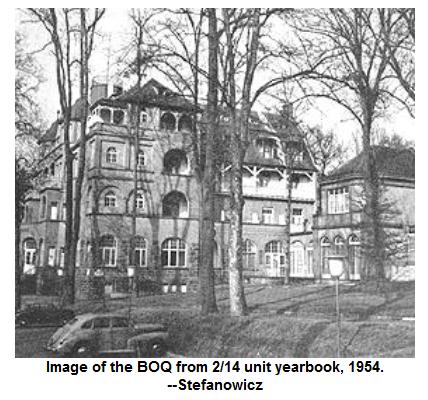
"CPT M.D. Woehlers, the Squadron Surgeon, certainly had the
medical side of the house under control and the NCOs were taking
care of the other medical platoon responsibilities, I threw myself
into the O Club mission. LTC Palmers guidance to me was brief and
to the point, 'I want this to be the best small club in Germany
... now get out!' I read every regulation and every change, read
the booklets and pamphlets, talked to everyone I could find."
"The club had great potential and the SCO wanted it fully
realized. We had a German cook and a couple of very attractive
German girls as waitresses. The club served both breakfast and
supper from a limit menu in the dining room; once I understood the
system, we began to improve the meals and variety. It took a while
to straighten out the financial and property records and bring us
into compliance with all the regulations, but I got this done.
Heinekens were sold for 25 cents and we organized foosball
tournaments, pool tournaments and poker nights and, common to the
clubs of the time, there were also slot machines. To provide some
additional funds to pay for both improvements and local
entertainment, I was able to 'skim' a portion of the slot proceeds
and SCO Palmer insured the club had good exposure with the
officers at Daley by making it the focus of Hails and Farewells
and other functions designed to bring the men back to the club.
And, in the case of one Lt from the FA unit at Daley, he came in
for a sandwich ... and left with a wife. We tried to be a full
service operation."
"I was only in BK for a year; by late 1968 I was in Vietnam and
that was an entirely different story. While there, I ran into
another officer who had recently served at Daley and he told me
that the club had passed all inspections by a USAREUR visiting
team shortly after my departure, the first time this had happened
in some time. The parting comment to the SCO was, 'This is the
best small club we have seen in Germany this year."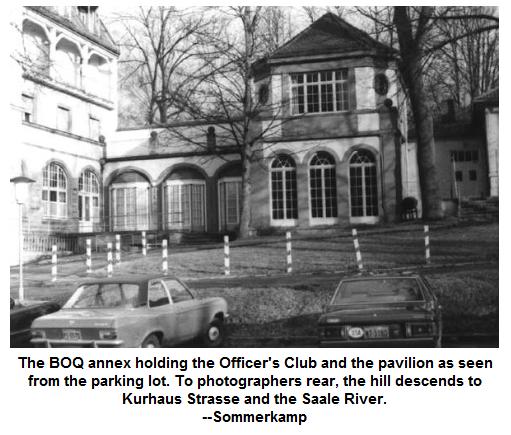
Colonel (Ret) John Byers adds:
"As Squadron Commander in 1968 and 1969, I developed a warm
relationship with Dr. Hans Weiss, the Lord Mayor of Bad Kissingen.
For display in the Officer's Club, he loaned us a copy of the
large painted mural showing the Battle for Bad Kissingen from the
German civil war as well as a 'carronade', a small cannon that had
actually been in that battle. These additions really dressed up
the place. "
Major (Ret) Mike McGehee:
“I lived in the BOQ for about ten months when I first arrived.
It had a wonderful location just on the edge of the town, the
building itself had a certain elegance although the elevator never
worked and the bathrooms in each set of quarters, in European
fashion, were not set up for showers, just those big porcelain
tubs and a hand shower arrangement. There was maid service that we
paid a fee for that did light cleaning and I think actually made
the beds!“
“The Officer’s Club in the side wing of the building was almost
never open, only used for formal affairs. Behind the building was
a coin operated laundry area that was always in use, particularly
when the Army switched over to the “wash and wear“ fatigue set. No
one seemed to mind if you washed your car in the parking lot, I
think in the housing area, this was not permitted due to water use
concerns.“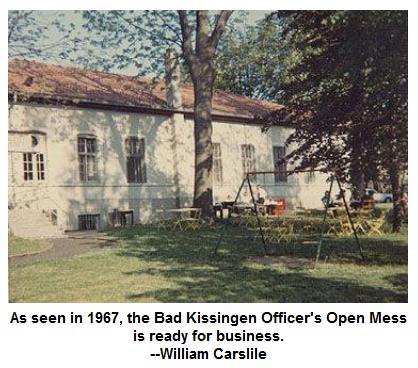
“The building manger was an older guy with a felt hat and a
long overcoat who drove around in a big Mercedes. He was retired
military and I think at some point had married a local girl and
settled in the area. I wish I had taken more time to get to know
him, I’m sure he had some interesting stories to tell.“
“I think it was October 1975 when, upon returning to my
quarters one night, I discovered a photo copied note on my bed
directing all occupants to find substitute housing because the
entire BOQ building was to be remodeled. I recall we were given
about two weeks to do this and it caused quite a scramble. I ended
up in Garitz and never went back. When I think of it, I do recall
that for the first two or three weeks in BK, I think I saw the
building in daylight once! Between the long hours at Daley, the
border and FTXs, I began to wonder if the sun ever shined on that
end of town.“
While the remodeling was a professional job, in 1976 the club
had problems. It was run as a satellite of the Schweinfurt
community, meals and the slot machines were gone. The Daley
Barracks Officer's Club went to limited operation then almost
closed due to lack of patronage by the mid 1977. It reopened in
1979 with a small remodeling effort partially paid for by the
local brewery, EKU, in exchange for exclusive distributor rights.
The club was only open Thursday, Friday and Saturday night. I
recall the menu was limited to pizza and hamburgers. One novel
addition was a first generation big screen TV and a video cassette
tape player. We watched the movie The Deer Hunter over and
over again. New management later installed an outdoor "cafe" and
towards the end of the US Army stay in Bad Kissingen, the
Eaglehorse built their own bar in an unused basement space of the
building
.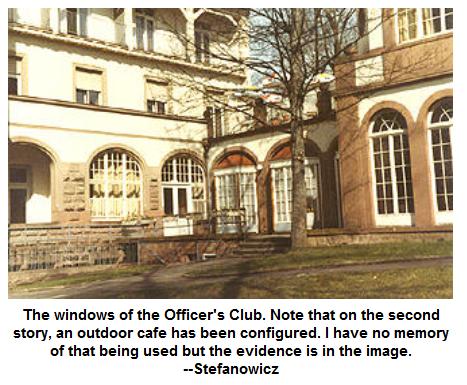
The club space also served as a meeting area for Eaglehorse
officer professional development classes. Captioning evidence from
the Saale Zeitung, indicates that this building was included in
the Daley Community upgrade in the mid 1980s.
A new page for the Marine Kurlazarett has finally begun. When
Norbert Ruckel first investigated the building, it was shuttered
and empty. Chunks of the stucco finish have scaled off the
exterior walls. The rehabilitation of the building has finally
begun in 2005 and it appears on its way to conversion to another
first class Bad Kissingen hotel. The other buildings on the BOQ
"campus" have been recycled into new uses. The former Officer's
Mess now supports a restaurant, the Medical Station is a health
club and so on.
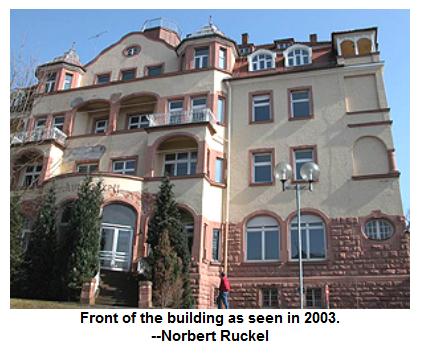 |
|
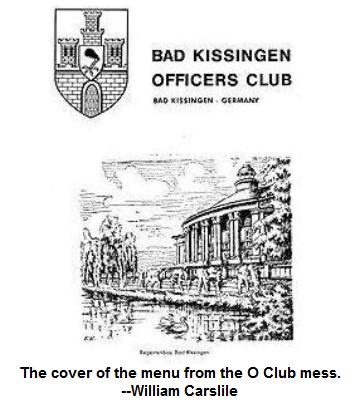 |
|
All the
pictures below were taken by Randy Mitchell in Sept 2003 |
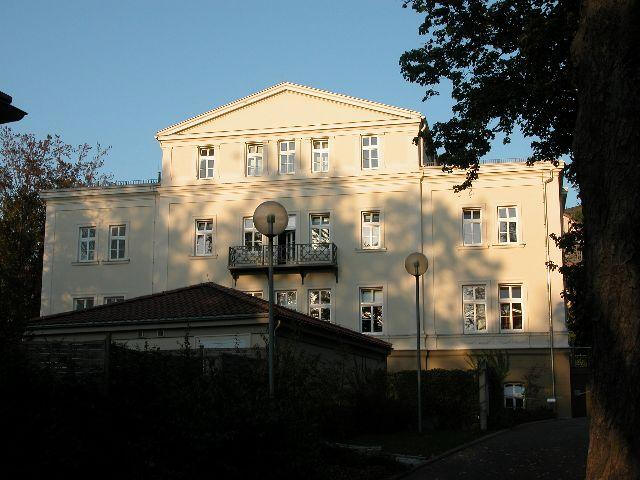 |
|
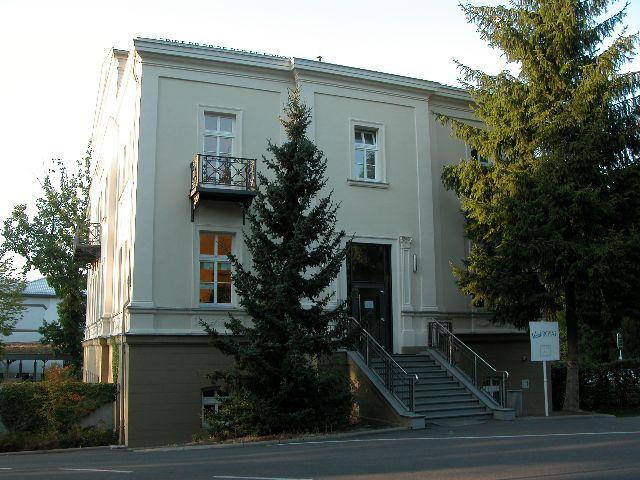 |
|
Same
building looking up from the BOQ parking lot. |
|
The MP Hqs and Dental Clinic in the upper portion of the BOQ
compound. This building appeared to now be a business office
of some sort. |
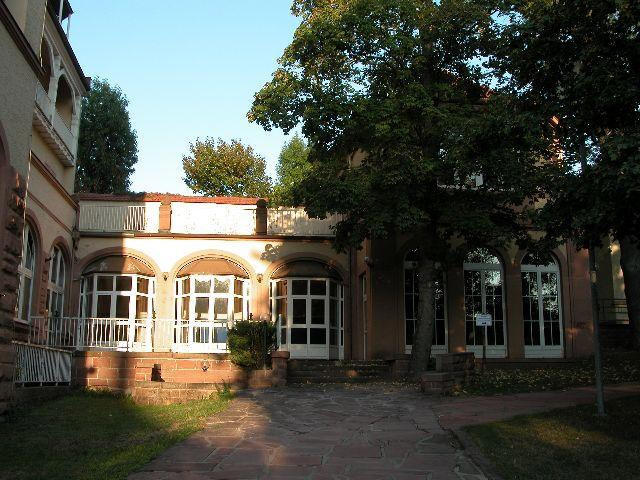 |
|
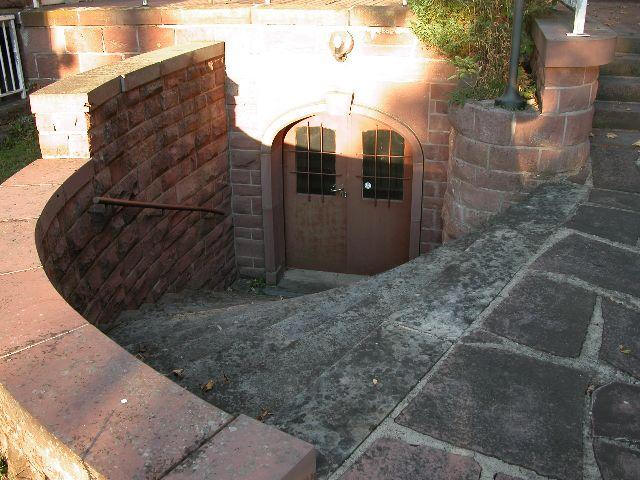 |
|
The
"wing" portion of what was the Officer club. There was an
upstairs "cupola" room the led out to an upper terrace. |
|
The "basement" O'Club 2/11 made for itself. |
|
|
|
|
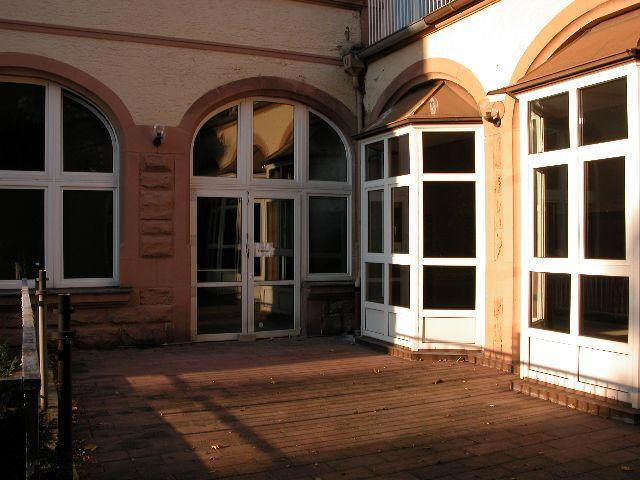 |
|
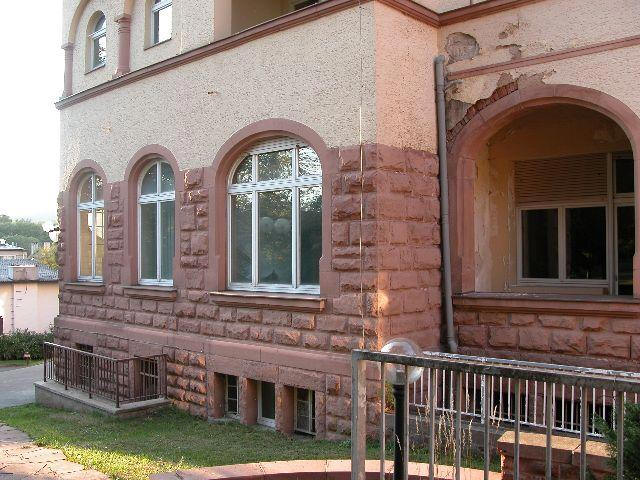 |
|
Entrance to the O'Club. This room was in-use for some
business purpose. |
|
Originally this forward section was BOQ rooms but with the
renovation in the early 1980s the club was expanded into these rooms
with additional tables and some game machines.
|
|
|
|
|
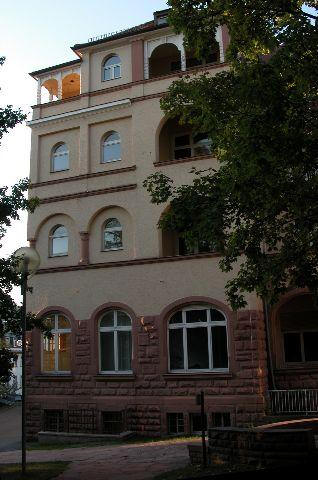 |
A nice side profile taken late on a Sunday
afternoon |
Enlisted Club
The Em Club supporting Daley Barracks dates back to the US arrival
at Manteuffel. It was built during the same wave of construction
that brought the Chapel, Rec Services, PX and other "lower Kaserne"
structures. It survives to this day, reconfigured as office space
and a day care center. The exterior now sports colorful murals.
|
|